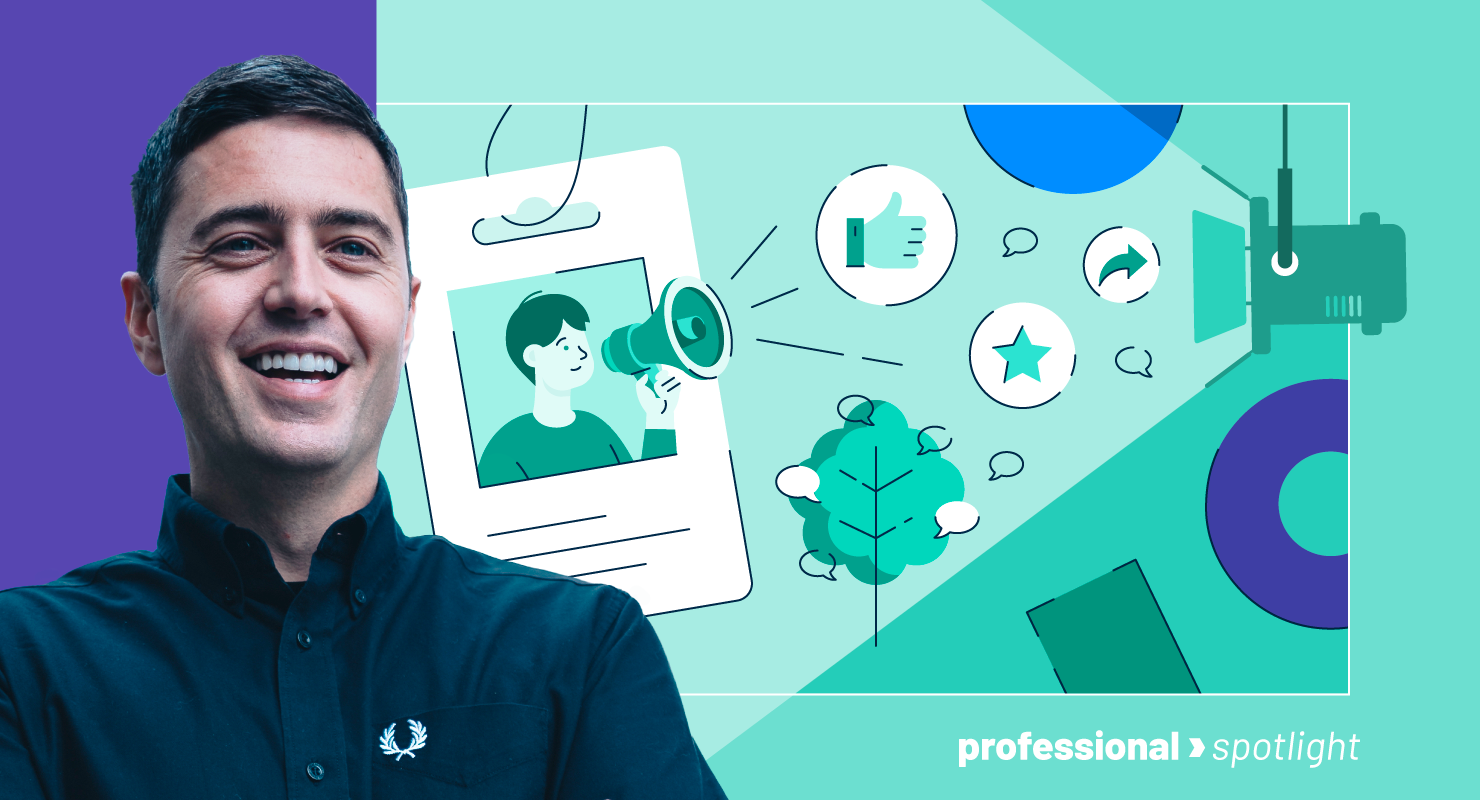September 6, 2023
 by Sudipto Paul / September 6, 2023
by Sudipto Paul / September 6, 2023

Achieving concrete business results with social media is no easy feat.
You probably share updates every week with your brand’s social media followers. But these posts barely cut through the clutter of content your audience sees daily. Paid ads can help, but they’re not the only solution for cutting through the white noise on social media. Audiences want authentic connections. They want to engage in conversations with people they know. That’s where an employee advocacy program comes in.
An employee advocacy program amplifies your brand reach using your employees’ smartly curated professional networks on social media channels.
Effective employee advocacy strategy significantly improve your company’s share of voice, lead generation, and website traffic without breaking the bank. These programs go beyond sharing business updates and company news, or having employees share their authentic work experiences.
I had the pleasure of chatting with Bradley Keenan, Founder & CEO of DSMN8, to learn how companies can harness their employees’ authenticity to improve social media reach and brand awareness. During our talk, Bradley shared his journey as a technology entrepreneur, how to find ideal advocate profiles, and ways to build an employee advocacy program from scratch.
This interview is part of G2's Professional Spotlight series. For more content like this, subscribe to G2 Tea, a newsletter with SaaS-y news and entertainment.
Sudipto Paul: Since you mentioned automation, I'm curious: what’s the one thing you’re looking to automate this year at DSMN8?
Bradley Keenan: When looking at what to automate, we consider anything that’s a manual process. Our platform automates as much as possible to leave the administrators room for creative thinking. For example, the platform automates the process of pulling content into the system and sharing notifications; it’s anything like that.
AI is huge for us right now. We use generative AI to help people create varied post captions. When sharing content, they can use AI to get ideas flowing, and that's been very effective.
Nice! Well, to get started, can you walk us through your journey so far, your background, and how you came to be where you are today?
I’ve worked in sales all my life. In 2003, I was the first salesperson for an online product video production company, back when that was in its infancy. We didn’t call them account executives during my early career.
I left that company in 2009 to start my own business, which was an e-commerce technology company called E-Tale. We helped consumers locate products through manufacturer websites. E-Tale was acquired in 2014, and I spent the following two years working for the company that acquired the business.
In 2016, I started working on DSMN8 and launched it in 2018.
You’ve built two technology companies over the last two decades. In your experience, what’s the key to finding product market fit?
Many people talk about starting with your passion. But if I had followed my passion, I would be a failed musician. The smart thing to do is find a problem and see if enough people have the same problem.
Once you find enough of them, and when some of them are large companies with big budgets, your next task is to create a way to solve that problem. If you can provide a solution, you’ll have an eager market within which to sell your product.
That makes sense. How did you come up with the idea of DSMN8, and what inspired you?
It's an interesting story. When you're a founder of a company that's been acquired, the company wants you to be around in case something goes wrong. In reality, they might not really need you for the day-to-day running of the business. So, you may be allocated a role, but have to pivot to find your new purpose.
I spent two years working in their marketing team. I wanted to produce social media content that helped the new team of salespeople sell the product that my company had built. However, I found it hard to get them to share it for several key reasons.
Inspired by overcoming these barriers, I decided I was going to create a new business once my contract concluded. The idea was to help employees become more active on social media in a safe and manageable way that protects companies from brand compliance-related issues.
As you mentioned, there’s a disconnect between sales and marketing. What is your advice for companies looking to address this?
Companies without an employee advocacy program should start by speaking to the senior leadership of different departments. Connect with departments you think will benefit most from running an advocacy program.
For example, if you want salespeople to be more active on social media, you should ensure the sales leadership sees the value of it first. It isn’t easy to onboard employees without the leaders singing from the same hymn sheet.

Every Thursday, we spill hot takes, insider knowledge, and news recaps straight to your inbox. Subscribe here
How do you think employee advocacy can influence the share of voice and the number of inbound leads a company generates? Can you share some examples of companies that have done it well?
Let’s talk about salespeople and customer-facing teams.
Your salespeople meet buyers from different companies. Chances are high that these buyers also connect with all your competitors. The salesperson frequently sharing the most valuable content will be the first person a buyer thinks of while choosing a product or service. Sharing content on social media on a regular basis results in a sales team dominating the share of voice in their category.
We have over 150 enterprise customers. McKinsey & Company is a good example. They have over 9,000 active ambassadors, a large percentage of their organization.
“Generally, when people are active on social media, they share around two content pieces a week, typically driving three to seven unique users to their website.”
Bradley Keenan
Founder and CEO, DSMN8
All of our clients get this kind of result.
Can you think of any small business that’s doing it really well?
Yes, we can use ourselves as an example. We’re a small company and we don’t spend any money on Google Ads. 70% of our website visitors come from social media referral traffic. Plus, we’ve grown our social media followers to over 25,000 in 18 months.
These are impressive numbers. If a company is to start an employee advocacy program today, how should they go about finding ideal advocates, and what kind of content should they start with?
We advise people to create an ideal advocate profile, which depends on a company’s objectives and the individuals working there. If you want to sell more, you should encourage salespeople to be more active. If hiring engineering talent, you should get your engineers to be more engaged on social media. That way, you can reach people they went to university or worked with previously, using their network to achieve your goals.
Whether the goal is sales or talent-based, what we typically call ‘company content’ is a valuable employee advocacy resource.
For example, I can share news about what’s happening at DSMN8 or product updates. Then, there’s news about marketing and technology instead of DSMN8. The final type is company culture content, which can showcase team away days or the experience of being an employee with our organization. The kind of content you share depends a lot on your company's objectives.
What are the typical challenges companies face when they start an advocacy program? And how do you think they can solve these problems?
There are two main challenges: executive buy-in and user adoption.
One of the concerns for somebody joining an advocacy program is that if they've never shared content before and they suddenly start sharing lots, it may look like they are potentially looking for a new job. And that's a worry for them.
“When you ask employees to join a program, they will only do it if they believe it's something the senior leadership supports.”
Bradley Keenan
Founder and CEO, DSMN8
The best way to address this is to have senior-level executives say this is something we support and want you to be involved in.
Secondly, you're asking people to do something that isn't in their job description and to go above and beyond their role. So frame the advocacy program as being beneficial to them and their career. Start by showing them how being more active on social media helps them create a personal brand, become better known inside the organization, and achieve their personal goals.
Since you talked about buy-in, how do you think leaders can convince companies to invest in employee advocacy, especially in today’s challenging market conditions?
This is an easy question. Most companies will have spent a lot of money on digital media over the last couple of years. If you go and buy advertising with LinkedIn, you could be paying up to $20 for a click. By getting your employees to be more active, you can distribute or re-align your marketing budget more efficiently.
When an employee shares content, there's no cost associated with it except the program cost. So, the cost per click comes down to under $1. The cost per click for an average DSMN8 client is about 44 cents.
The senior leadership should look at how an advocacy program will get the company more marketing reach for considerably less budget by engaging employees.
I liked the example you gave about the cost per click. When a company invests in an employee advocacy program, how long does it take to get a return on investment?
When somebody shares something clickable, branded content, video, or even images on social media, the benefit of that share happens immediately. For most of our clients, the social share is the second- or third-highest referral of traffic to the website outside of search engines like Google.
As soon as you launch a program with, let's say, 100 people, there'll be a sizable difference in the web traffic that your social media channels generate.
Can you share some employee advocacy tips for companies looking to build and scale an advocacy program from scratch?
Companies should start by having a good grasp of their current state. One way to do this is to look at how many of your employees are already actively sharing content. Companies usually have less than 5% of their employees sharing content. When it comes to salespeople, the number doesn’t increase much. Typically, 9% of salespeople share on social media. When 91% of salespeople are entirely silent, that tells you there’s an untapped opportunity.
If you run those numbers again after six months of starting your advocacy program, you’re likely to see a noticeable difference in online engagement. At DSMN8, we create these reports for new and prospective clients. We call it an ‘employee advocacy health check’, and that’s where companies can start.
You’re publishing a book called Employee Advocacy: 101 Cheat Codes this September. Could you give us a sneak peek of what to expect?
I get frustrated when I read business books because they say the same thing repeatedly. You can read a 300-page book, but end up learning only one thing.
What we wanted to do with the Employee Advocacy: 101 Cheat Codes was to have every single page deliver value. The book has 101 tips, but we call them cheat codes (a nod to our love of gaming).
[Bradley opens the book and starts sharing tips from it]
Let's pick a random page. We're on page 55, discussing how to write multiple post captions with varying tones.
You shouldn't give the same content piece with the same text to every employee. If you do that and everybody shares the same content on the same day, it'll look like LinkedIn has been taken over by bots! We advise companies to provide captions with varying tones so that when an employee selects the piece of content they want to share, they can find something most suited to their personal tone of voice.
I'll give you one more.
The 36th cheat code talks about limiting how much employees can share. It may sound counterproductive because we want our employees to be active, but when somebody gets excited, they might share too much. You don't want an employee sharing more than one piece of content daily. Two is quite a lot.
People who are new to social media might think that the more they share, the better. When they share 10-15 posts in one day, it looks inauthentic, which is the exact opposite of what we want to achieve with employee advocacy.
That’s interesting. So, we have individual contributors, managers, and then c-suite executives. What kind of differentiation should there be regarding the content they share on social media?
You’ll want to produce content and captions that are appropriate for different perspectives and career stages. You might provide thought leadership posts to the more senior people within the organization, with authoritative captions, that would be less credible if shared by junior staff members. This can also be a valuable strategy to control the narrative if a company wishes to make a stance on public or business issues.
Junior employees can also add value by engaging with content shared by other advocates, as well as sharing themselves. For example, when the vice president (VP) of sales shares a post, your sales team can interact with likes and comments to boost its reach.
Follow Bradley on LinkedIn to learn how to turn employees into social media brand ambassadors and grow your employee advocacy program.
Sudipto Paul leads the SEO content team at G2 in India. He focuses on shaping SEO content strategies that drive high-intent referral traffic and ensure your brand is front-and-center as LLMs change the way buyers discover software. He also runs Content Strategy Insider, a newsletter where he regularly breaks down his insights on content and search. Want to connect? Say hi to him on LinkedIn.
Building extraordinary is a continuous process that requires commitment and a clear vision....
 by Washija Kazim
by Washija Kazim
If you're in sales or customer success, you know how your company is pulling out all the stops...
 by Sudipto Paul
by Sudipto Paul
How do you get hundreds and thousands of employees excited enough about your company updates...
 by Anita Lankinen
by Anita Lankinen
Building extraordinary is a continuous process that requires commitment and a clear vision....
 by Washija Kazim
by Washija Kazim
If you're in sales or customer success, you know how your company is pulling out all the stops...
 by Sudipto Paul
by Sudipto Paul


